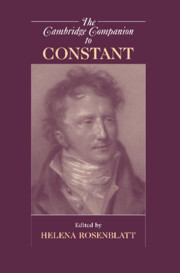Book contents
- Frontmatter
- Introduction
- 1 Benjamin Constant: Life and Work
- Part I The Political Thinker and Actor
- Part II The Psychologist and Critic
- Part III The Analyst and Historian of Religion
- 12 Religion According to Constant
- 13 Constant on the Religious Spirit of Liberalism
- 14 Constant and Religion: “Theism Descends from Heaven to Earth”
- Conclusion
- 15 Eclipses and Revivals Constant’s: Reception in France and America 1830-2007
- Bibliography
- Index
- Series List
12 - Religion According to Constant
from Part III - The Analyst and Historian of Religion
Published online by Cambridge University Press: 28 July 2009
- Frontmatter
- Introduction
- 1 Benjamin Constant: Life and Work
- Part I The Political Thinker and Actor
- Part II The Psychologist and Critic
- Part III The Analyst and Historian of Religion
- 12 Religion According to Constant
- 13 Constant on the Religious Spirit of Liberalism
- 14 Constant and Religion: “Theism Descends from Heaven to Earth”
- Conclusion
- 15 Eclipses and Revivals Constant’s: Reception in France and America 1830-2007
- Bibliography
- Index
- Series List
Summary
Benjamin Constant, the great theorist of liberal democracy and peerless connoisseur of human psychology, had a third ambition, which was more important to him than the vocation of politician or writer: he hoped to analyze one of the most notable aspects of human existence, namely, religion. He conceived this project in 1785, when he was eighteen, soon after finishing his studies. And he was still correcting his manuscript in October 1830, a month before his death. Between those two dates, the idea and the text were always with him, and despite repeated interruptions he worked on them constantly. The first volumes of De la religion (On Religion) appeared in 1824; the last, volumes four and five, were published shortly after his death, in 1831.
The book was the work of a lifetime, yet it stirred little debate when it appeared and was quickly forgotten. Only erudite historians and devotees of Constant are even aware of its existence. No other edition of the complete work ever appeared until 1999. What accounts for this reception? It must be said that the book’s timing was not propitious. In nineteenth-century France, the devout and the anticlerical were locked in fierce battle for or against religion. Impossible to place in relation to this conflict, Constant was of no use to either side.
- Type
- Chapter
- Information
- The Cambridge Companion to Constant , pp. 275 - 285Publisher: Cambridge University PressPrint publication year: 2009

